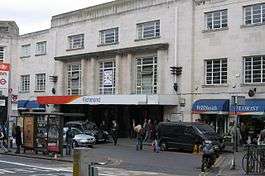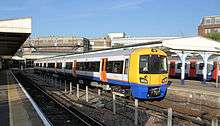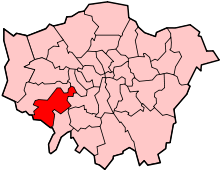Richmond station (London)
Richmond, also known as Richmond (London), is a National Rail station in Richmond, Greater London on the Waterloo to Reading and North London Lines. South Western Railway services on the Waterloo to Reading Line are routed through Richmond, which is between North Sheen and St. Margarets stations, 9 miles 57 chains (15.6 km) down the line from London Waterloo.[6] For London Overground and London Underground services, the next station is Kew Gardens.
| Richmond | |
|---|---|
 Main entrance, on Kew Road. The apron shown has now been pedestrianised. | |
 Richmond Location of Richmond in Greater London | |
| Location | Richmond |
| Local authority | London Borough of Richmond upon Thames |
| Managed by | South Western Railway |
| Owner | Network Rail |
| Station code | RMD |
| DfT category | B |
| Number of platforms | 7 |
| Accessible | Yes[1][2] |
| Fare zone | 4 |
| London Underground annual entry and exit | |
| 2014 | |
| 2015 | |
| 2016 | |
| 2017 | |
| 2018 | |
| National Rail annual entry and exit | |
| 2014–15 | |
| – interchange | |
| 2015–16 | |
| – interchange | |
| 2016–17 | |
| – interchange | |
| 2017–18 | |
| – interchange | |
| 2018–19 | |
| – interchange | |
| Key dates | |
| 1846 | Opened as Terminus (R&WER) |
| 1848 | Station moved (WS&SWR) |
| 1869 | Opened (L&SWR via Hammersmith) |
| 1869 | Started (NLR) |
| 1870 | Started and Ended (GWR) |
| 1877 | Started (MR and DR) |
| 1894 | Started (GWR) |
| 1906 | Ended (MR) |
| 1910 | Ended (GWR) |
| 1916 | Ended (L&SWR via Hammersmith) |
| 1937 | Stations merged (SR) |
| Other information | |
| External links | |
| WGS84 | 51.463°N 0.300°W |
Architecture
The station building, designed by James Robb Scott in Portland stone[7] and dating from 1937, is in Art Deco style and its facade includes a square clock.[8] The area in front of the station main entrance was pedestrianised in 2013[9] and includes a war memorial to soldier Bernard Freyberg, who was born in Richmond.
History
The Richmond and West End Railway (R&WER) opened the first station at Richmond on 27 July 1846,[10] as the terminus of its line from Clapham Junction,[11] on a site to the south of the present through platforms, which later became a goods yard and where a multi-storey car park now stands. The Windsor, Staines and South Western Railway (WS&SWR) extended the line westward, resiting the station to the west side of The Quadrant, on the extended tracks and slightly west of the present through platforms. Both the R&WER and WS&SWR were subsidiary companies of the London and South Western Railway (L&SWR).
On 1 January 1869,[12] the L&SWR opened a line to Richmond from north of Addison Road station (now Kensington (Olympia) station) on the West London Joint Railway. This line ran through Hammersmith (Grove Road) station, since closed, and Turnham Green and had connection with the North & South Western Junction Railway (N&SWJR) near Gunnersbury. Most of this line is now part of the London Underground District line; the line south from Gunnersbury was also served by the North London Railway (NLR) and is now used also by London Overground. Before this line was built, services north from Richmond ran somewhat circuitously via chords at Kew Bridge and Barnes.
The Great Western Railway (GWR) briefly (1 June to 31 October 1870)[10] ran a service from Paddington to Richmond via the Hammersmith & City Railway (now the Hammersmith & City line) tracks to Grove Road and then over the L&SWR tracks through Turnham Green.
On 1 June 1877, the District Railway (DR) linked its then terminus at Hammersmith to the nearby L&SWR tracks east of the present Ravenscourt Park station. The DR began running trains over the L&SWR tracks to Richmond.[12] On 1 October 1877,[10] the Metropolitan Railway (MR, now the Metropolitan line) restarted the former GWR service to Richmond via Grove Road station.
The DR route from Richmond to central London via Hammersmith was more direct than those of the NLR via Willesden Junction, of the L&SWR and the MR via Grove Road station and of the L&SWR via Clapham Junction to Waterloo. From 1 January 1894,[10] the GWR began sharing the MR Richmond service, resulting in Gunnersbury having the services of five operators.
After electrifying its tracks north of Acton Town in 1903, the DR funded the electrification, completed on 1 August 1905, from Gunnersbury to Richmond.[12] The DR ran electric trains on the branch, while the L&SWR, NLR, GWR and MR services continued to be steam hauled.
MR services ceased on 31 December 1906 and those of the GWR on 31 December 1910,[10] leaving operations northwards through Kew Gardens and Gunnersbury to the DR (by then known as the District Railway), the NLR and L&SWR. On 3 June 1916, the L&SWR withdrew its service from Richmond to Addison Road through Hammersmith due to competition from the District line,[10] leaving the District as the sole operator over that route and the NLR providing main line services via Willesden Junction.
Under the grouping of 1923, the L&SWR became part of the Southern Railway (SR) and the NLR became part of the London, Midland and Scottish Railway (LMS); both were subsequently nationalised into British Railways. On 1 August 1937, the SR opened its rebuilt station with the station building and the through platforms moved east to be next to the terminal platforms. At around the same time, the SR moved the goods yard from the site of the original terminus to a new location north-east of the station.
Accident
On 18 September 1987, an accident occurred at Richmond when a westbound District line hit the buffers of platform 6 and broke the glass/perspex panels behind. No passengers were seriously injured.[13]
Crossrail
A Crossrail branch to Kingston upon Thames via Richmond was proposed in 2003, but was dropped in 2004 due to a combination of local opposition, complex choices and engineering at the start of the route, cost, and insufficient return on investment. It could have run either overland or via a tunnel to Turnham Green and on the existing track through Gunnersbury to Richmond (which would have lost the District line service) and thence to Kingston.
Platforms
Richmond station | |||||||||||||||||||||||||||||||||||||||||||||||||||||||||||||||||
|---|---|---|---|---|---|---|---|---|---|---|---|---|---|---|---|---|---|---|---|---|---|---|---|---|---|---|---|---|---|---|---|---|---|---|---|---|---|---|---|---|---|---|---|---|---|---|---|---|---|---|---|---|---|---|---|---|---|---|---|---|---|---|---|---|---|
| |||||||||||||||||||||||||||||||||||||||||||||||||||||||||||||||||

The station has seven platforms numbered from south to north:
- Platforms 1 and 2 are through platforms for South Western Railway services.
- Platforms 3 to 7 are terminating platforms used by:
- London Overground North London line services (normally platforms 3 and 4 but sometimes 5, 6 and 7)
- London Underground District line services (normally platforms 5, 6 and 7. Occasionally 4 but never 3 due to 3's lack of a fourth rail, which the District Line uses for electric power).
As of September 2011, work was under way to extend platforms 1 and 2 to accept 10-car trains.[14] The bulk of the lengthening was to be at the west (country) end; extending eastwards was deemed unviable by Network Rail as Church Road Bridge would have needed widening.[15] As part of these works, the platform canopies were also being refurbished.
The wide gap between platforms 3 and 4 originally had a third, run-around track for steam locomotives.
Eight retail units are at the station: four eatery-cafés on alternate sides of the barriers (two on the rail side being thin and smaller) similarly two kiosks, the upper one being a hot drinks kiosk through to a M&S Simply Food grocery store. A florist and a WH Smith flank the entrance.
Off peak service
The typical off-peak service in trains per hour is:
- 8 direct to Waterloo (South Western Railway)
- 2 fast calling at Clapham Junction only
- 2 semi fast calling at Putney, Clapham Junction and Vauxhall
- 4 all stations
- 8 direct from Waterloo (South Western Railway)
- 2 to Reading
- 2 to Windsor & Eton Riverside
- 2 indirectly returning to Waterloo via Hounslow and Brentford
- 2 indirectly returning to Waterloo via Kingston and Wimbledon
- 4 to Stratford (London Overground)
- 6 to Upminster via Tower Hill (District line)
Transport links
London Buses serving nearby are:
| Route | Start | End | Operator |
| 33 | Fulwell | Hammersmith | London United |
| 65 | Kingston Chessington |
Ealing Broadway | London United |
| 190 | West Brompton | Richmond | Metroline |
| 337 | Clapham Junction | Richmond | Go-Ahead London |
| 371 | Kingston | Richmond | London United |
| 391 | Sands End | Richmond | London United |
| 419 | Hammersmith | Richmond | London United |
| 490 | Heathrow Airport Terminal 5 | Richmond | Abellio London |
| 493 | Tooting | Richmond | Go-Ahead London |
| 969 | Whitton | Roehampton Vale | Abellio London |
| H22 | Hounslow | Richmond | London United |
| H37 | Hounslow | Richmond | London United |
| R68 | Kew | Hampton Court | Abellio London |
| R70 | Hampton | Richmond | Abellio London |
| N22 | Piccadilly Circus | Fulwell | Go-Ahead London |
| N65 | Chessington | Ealing Broadway | London United |
A taxi rank is near the station entrance on Kew Road. Steps or lifts can be used to reach all platforms.
An extensive bike storage facility is east outside the back entrance, Church Road, linked by 27 steps to a set of ticket barriers and the main platform area connecting platforms 2–7.
References
- "Step free Tube Guide" (PDF). Transport for London. May 2020. Archived (PDF) from the original on 7 August 2020.
- "London and South East" (PDF). National Rail. September 2006. Archived from the original (PDF) on 6 March 2009.
- "Multi-year station entry-and-exit figures (2007-2017)" (XLSX). London Underground station passenger usage data. Transport for London. January 2018. Retrieved 22 July 2018.
- "Station Usage Data" (CSV). Usage Statistics for London Stations, 2018. Transport for London. 21 August 2019. Retrieved 27 April 2020.
- "Station usage estimates". Rail statistics. Office of Rail Regulation. Please note: Some methodology may vary year on year.
- Yonge, John (November 2008) [1994]. Jacobs, Gerald (ed.). Railway Track Diagrams 5: Southern & TfL (3rd ed.). Bradford on Avon: Trackmaps. map 1L. ISBN 978-0-9549866-4-3.CS1 maint: ref=harv (link)
- Bridget Cherry and Nikolaus Pevsner (1983). The Buildings of England – London 2: South. London: Penguin Books. p. 521. ISBN 0-14-0710-47-7.
- "Art Deco Gallery – Stations etc". london-footprints.co.uk. 2011. Retrieved 12 August 2013.
- "'Jewel in the Crown' of a historic Town centre". Construct. FM Conway. Spring 2013. Retrieved 7 September 2013.
- Clive's Underground Line Guides – Hammersmith & City Line
- Clive's Underground Line Guides – Hammersmith & City Line
- Clive's Underground Line Guides – District Line
- "Underground train crashes: Richmond 18-9-87". Thames News. Youtube. Retrieved 13 April 2018.
- Archived 15 July 2012 at Archive.today
External links
| Wikimedia Commons has media related to Richmond station (London). |
- Train times and station information for Richmond station (London) from National Rail
- Transport for London Richmond station
- www.Old-maps.co.uk — Richmond station, 1871
| Preceding station | Following station | |||
|---|---|---|---|---|
| Terminus | North London Line | towards Stratford |
||
| Terminus | District line North London Line | towards Upminster |
||
| North Sheen | South Western Railway Hounslow/Kingston loop line |
St Margarets | ||
| Putney | South Western Railway Waterloo - Windsor |
Twickenham | ||
| Clapham Junction | South Western Railway Waterloo - Reading |
Twickenham | ||
| Former services | ||||
| Terminus | London and South Western Railway (1869-1916) |
Kew Gardens towards West Brompton | ||
| Metropolitan Railway (1877-1906) |
Kew Gardens towards Paddington | |||
| Great Western Railway (1894-1910) |
||||
| Abandoned Plans | ||||
| Terminus | Central line (1913 & 1920) | towards Liverpool Street |
||
